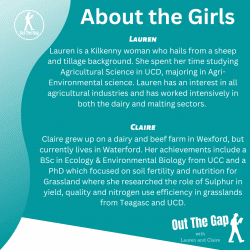Out The Gap – Issue 7


National Fertiliser Database
A new National Fertiliser Database has been established by the Department of Agriculture, Food and the Marine (DAFM). The DAFM portal for farmers who will be referred to as “Fertiliser End User” is open. This portal is also open for “Fertiliser Economic Operators” which includes co-ops, merchants and fertiliser companies. Out The Gap attempt to break this down.
Upon registration, farmers herd numbers will be used to account for fertiliser transactions. It is the responsibility of the merchant or co-op to report this data to DAFM. The deadline for declaration of closing stock is 23:59 September 14th 2023 (including nil) of farmers must be declared by 15th October 2023. Declaration of closing stock is a requirement of the legislation and sanctions may include a fine under this legislation rather than cross compliance.
Concern, unease and perhaps even anger may circulate many Irish Farmers minds around such mitigation practices to try improve water quality and environmental ambitions. But are these the key to safeguard the Nitrates Derogation? We’ll let you decide that one.
While the database has been launched and the IFA protest for Farmers’ Futures, we continue to strive towards a more sustainable and environmentally responsible agriculture, while minimizing N use and its potential negative impacts on water quality and ecosystems.
A simple soil test will help determine fertiliser needs. Regularly testing the soil to assess nutrient levels accurately and avoid unnecessary fertilisation is essential. Appling lime will not only increase efficiency of chemical fertiliser application but will also form the foundation for a healthy environment for soil microbial biomass production. Similar to the effect one too many lemonades on a Saturday night can have on our stomachs, poor soil pH will promote unfavored soil biology.

Labile soil N refers to the pool of N that is readily transformed to plant available N for plant uptake. Nitrogen can therefore exist in different forms, including ammonium (NH4+) and nitrate (NO3–), as well as organic N in the form of decomposing organic matter. Labile N plays a crucial role in soil fertility and plant nutrition. It acts as a primary source of N for crops, and its availability directly impacts plant growth and productivity. However, over suppling chemical N with the soils ability to release N can lead to loss of N to the environment.
Perhaps if we understood and managed labile soil N better, we could optimize it’s availability for crops while minimizing the need for chemical N and therefore losses to the environment. Some management practices to consider:
- Using slow-release fertilizers or split applications to synchronize N availability with crop demand could deliver desirable chemical N reductions.
- Maintaining or increasing organic matter content in the soil, as it releases N slowly and provides a more stable N source.
- Encourage nitrogen-fixing bacteria in the soil, such as Rhizobium in legumes, to contribute to the biological N Fixation.
- Maintaining optimum soil pH.
- Limiting soil compaction while improving soil structure and increasing root depth and density
Incorporate leguminous crops (e.g. clover, peas, beans) that can fix atmospheric N (N2) into the soil with the help of nitrogen-fixing bacteria.
Managing labile soil N is a delicate balance between meeting crop demands and minimizing environmental impacts. Different soils and cropping systems may require specific approaches, so it’s essential to consider site-specific factors and seek advice from local Grassland Agro agronomists for tailored recommendations.
it’s under our feet

